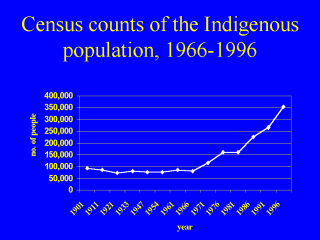|
|
|
|
front |1 |2 |3 |4 |5 |6 |7 |8 |9 |10 |11 |12 |13 |14 |15 |16 |17 |18 |19 |20 |21 |22 |23 |24 |25 |26 |27 |28 |29 |30 |31 |32 |33 |34 |review |
 |
As
the graph shows, since the 1967 referendum, there have been large increases from
one census to the next in the number of people who indicated that they were of
Aboriginal or Torres Strait Islander origin. Although one might expect a big
jump in 1971 (the first Census after the 1967 referendum) followed by a leveling
off, the increase has instead been gradual and sustained, and the increases from
one census to the next are larger than can be explained by demographic factors
(births, deaths and migration). For example, only about half of the increase
between 1991 and 1996 can be explained by demographic factors. The rest of the
increase is most likely explained by an increased willingness of people to
indicate their Indigenous origin on a government form. (Improved enumeration of
Indigenous people by the Australian Bureau of Statistics may also have
contributed.). As has been the case in many developed countries, it has often
been in the interests of Indigenous people to avoid being identified as such by
the government. (For example, see background information on the The National
Inquiry into the Separation of Aboriginal and Torres Strait Islander Children
from Their Families, available at the Human Rights and Equal Opportunities
Commission website on http://www.hreoc.gov.au/social_justice/ Australian census forms are destroyed immediately after they are processed, and it is not possible to link people’s records over time to identify those people who changed the way they answered the question, so it is difficult to characterize them. For
more information about these issues, see Ross K., 1999. Occasional Paper:
Population Issues, Indigenous Australians, 1996. ABS cat. no. 4708.0,
Australian Bureau of Statistics, Canberra. (Available on-line at http://www.abs.gov.au/Ausstats/ |